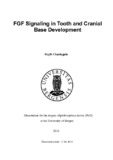Please use this identifier to cite or link to this item:
http://archive.nnl.gov.np:8080/handle/123456789/354| Title: | FGF Signaling in Tooth and Cranial Base Development |
| Authors: | Chaulagain, Rajib |
| Keywords: | Craniofacial development is a complex process FGFR2b appears to regulate development of dental vasculature |
| Issue Date: | 27-Mar-2019 |
| Abstract: | Craniofacial development is a complex process. Recent advanced molecular techniques and gene targeting studies have enriched our understanding of craniofacial development. Fgfs and isoforms of Fgfrs are expressed in the tooth germ and developing cranial base suggesting that they have essential roles in odontogenesis, organ vascularisation and bone development. Mutations in gene encoding FGFs and FGFRs have been associated with chondrodysplasias and craniosynostosis where the development and growth of the craniofacial region is mostly affected. Objective: To investigate the expression of Fgf11-18 and -20 in the developing tooth germ, and expression of Fgfr isoforms and function of FGFR2b in the developing cranial base. To compare additionally the development of blood vessels and nerves during tooth development. Materials and methods: Wild type and Fgfr2b knockout mouse strains were used in the project. In situ hybridization was employed to detect mRNAs in tooth and cranial base tissue sections. Immunohistochemistry was utilized to localize blood vessels and neurites in teeth and different histochemical methods were used to study cartilage and bone of the cranial base. Results: Fgf11-13, Fgf15-17 and Fgf20 are expressed in the developing tooth germ. In addition, formation of dental vasculature and innervation are independently developmentally regulated. Except Fgfr1b, all the isoform variants of Fgfr are expressed in the embryonic mid-sagittal cranial base. Analysis of Fgfr2b deficient mice revealed abnormal vascularisation in the developing teeth. Moreover, in the cranial base changes were observed after the mesenchymal condensation period during the endochondral ossification. Conclusions: The expression of Fgfs in the tooth germ and the different isoforms of Fgfrs in the developing cranial base suggest that FGF signaling plays important roles in odontogenesis and development of the cranial base. The development of vascular supply and innervation in the tooth takes place in a distinct developmentally regulated manner and FGFR2b appears to regulate development of dental vasculature. |
| URI: | http://103.69.125.248:8080/xmlui/handle/123456789/354 |
| Appears in Collections: | 500 Natural sciences and mathematics |
Files in This Item:
| File | Description | Size | Format | |
|---|---|---|---|---|
| Chaulagain Thesis.pdf | 49.83 MB | Adobe PDF |  View/Open |
Items in DSpace are protected by copyright, with all rights reserved, unless otherwise indicated.